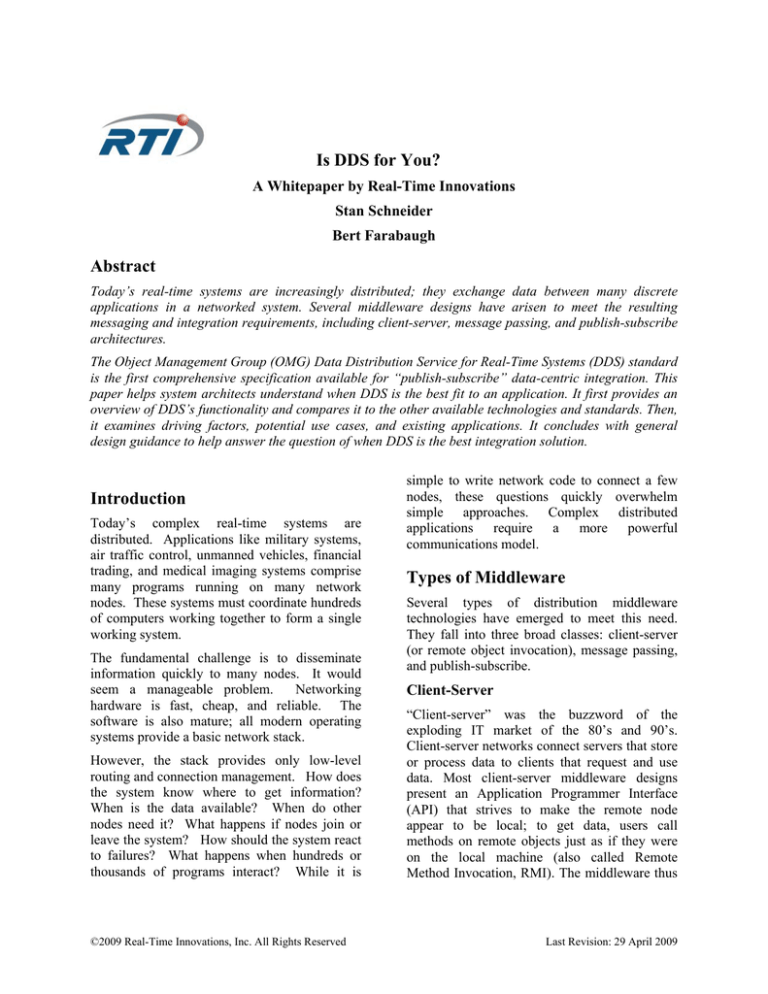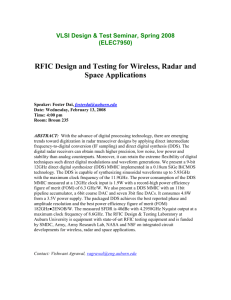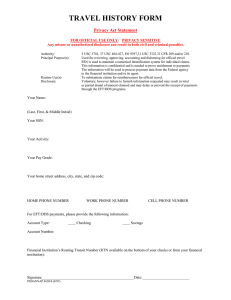
Is DDS for You?
A Whitepaper by Real-Time Innovations
Stan Schneider
Bert Farabaugh
Abstract
Today’s real-time systems are increasingly distributed; they exchange data between many discrete
applications in a networked system. Several middleware designs have arisen to meet the resulting
messaging and integration requirements, including client-server, message passing, and publish-subscribe
architectures.
The Object Management Group (OMG) Data Distribution Service for Real-Time Systems (DDS) standard
is the first comprehensive specification available for “publish-subscribe” data-centric integration. This
paper helps system architects understand when DDS is the best fit to an application. It first provides an
overview of DDS’s functionality and compares it to the other available technologies and standards. Then,
it examines driving factors, potential use cases, and existing applications. It concludes with general
design guidance to help answer the question of when DDS is the best integration solution.
Introduction
Today’s complex real-time systems are
distributed. Applications like military systems,
air traffic control, unmanned vehicles, financial
trading, and medical imaging systems comprise
many programs running on many network
nodes. These systems must coordinate hundreds
of computers working together to form a single
working system.
The fundamental challenge is to disseminate
information quickly to many nodes. It would
seem a manageable problem.
Networking
hardware is fast, cheap, and reliable. The
software is also mature; all modern operating
systems provide a basic network stack.
However, the stack provides only low-level
routing and connection management. How does
the system know where to get information?
When is the data available? When do other
nodes need it? What happens if nodes join or
leave the system? How should the system react
to failures? What happens when hundreds or
thousands of programs interact? While it is
©2009 Real-Time Innovations, Inc. All Rights Reserved
simple to write network code to connect a few
nodes, these questions quickly overwhelm
simple approaches. Complex distributed
applications require a more powerful
communications model.
Types of Middleware
Several types of distribution middleware
technologies have emerged to meet this need.
They fall into three broad classes: client-server
(or remote object invocation), message passing,
and publish-subscribe.
Client-Server
“Client-server” was the buzzword of the
exploding IT market of the 80’s and 90’s.
Client-server networks connect servers that store
or process data to clients that request and use
data. Most client-server middleware designs
present an Application Programmer Interface
(API) that strives to make the remote node
appear to be local; to get data, users call
methods on remote objects just as if they were
on the local machine (also called Remote
Method Invocation, RMI). The middleware thus
Last Revision: 29 April 2009
strives to hide the networked nature of the
system. Client-server middleware designs
include SOAP, HTTP, CORBA, and Enterprise
JavaBeans (EJB).
Also, messaging systems rarely allow control
over the messaging behaviors or real-time QoS.
Messages flow in the system when produced; all
streams have similar delivery semantics.
Client-server middleware technologies typically
build on top of TCP, the Transmission Control
Protocol. TCP offers reliable delivery, but little
control over delivery Quality of Service (QoS).
For instance, TCP retries dropped packets, even
if the retries take a lot of time. TCP requires
dedicated resources for each connection; since
each connection keeps track of the state of
messages. Thus, it takes time and significant
resources to set up and maintain connections.
TCP does not scale well for extended data
distribution.
Publish-Subscribe
Message Passing
Message-passing
architectures
work
by
implementing queues of messages as a
fundamental design paradigm. Processes can
create queues, send messages, and service
messages that arrive. This extends the many-toone client-server design to a more distributed
topology. With a simple messaging design, it’s
much easier to exchange information between
many nodes in the system.
Some operating systems use message passing as
a fundamental low-level synchronization
mechanism. Others provide it as a library
service (such as POSIX® message queues).
Many enterprise middleware designs implement
a message-passing architecture; for example,
IBM’s WebSphere MQ.
Message passing allows direct peer-to-peer
connections. However, message-passing systems
do not support a data-centric model. With
messages, applications have to find data
indirectly by targeting specific sources (by
process ID or "channel" or queue name) on
specific nodes. The model doesn't address how
you know where that process/channel is, what
happens if that channel doesn't exist, etc. The
application must determine where to get data,
where to send it, and when to do the transaction.
There is no real model of the data itself, there is
only a model of a means to transfer data.
©2009 Real-Time Innovations, Inc. All Rights Reserved
Publish-subscribe adds a data model to
messaging. Publish-subscribe nodes simply
"subscribe" to data they need and "publish"
information they produce. Messages logically
pass directly between the communicating nodes.
The fundamental communications model implies
both discovery—what data should be sent—and
delivery—when and where to send it. This
design mirrors time-critical information delivery
systems in everyday life including television,
radio, magazines, and newspapers. Publishsubscribe systems are good at distributing large
quantities of time-critical information quickly,
even in the presence of unreliable delivery
mechanisms.
Publish-subscribe designs are also not new.
Industrial automation “fieldbus” networks have
used publish-subscribe designs for decades.
Commercial
publish-subscribe
enterprise
solutions (e.g. Tibco Rendezvous) routinely
deliver information such as financial data from
stock exchanges. In the embedded space,
commercial middleware products, including
RTI® Data Distribution Service, control Navy
ships, traffic grids, flight simulators, military
systems, and thousands of other real-world
applications. The technology is proven and
reliable.
Middleware Summary
In summary, client-server middleware is best for
centralized data designs and for systems that are
naturally service oriented, such as file servers
and transaction systems. They struggle with
systems that entail many, often-poorly-defined
data paths.
Message passing implements “send that there”
semantics, and maps well to systems with clear,
simple dataflow needs. They are better than
client-server designs at free-form data sharing,
but still require the application to discover where
data resides.
Last Revision: 29 April 2009
Figure 1 Super-TV sends and receives many channels
Publish-subscribe includes both discovery and
messaging. Together, they implement a datacentric information distribution system. Nodes
communicate simply by sending the data they
have and asking for the data they need.
What is DDS?
DDS is a standard managed by the Object
Management Group (OMG), the systems
software standards body responsible for
technologies like middleware and modeling
languages (e.g. UML). The OMG DDS standard
is the first open international standard directly
addressing publish-subscribe middleware for
real-time systems. DDS features extensive fine
control of real-time QoS parameters, including
reliability,
bandwidth
control,
delivery
deadlines, and resource limits.
Above, we drew the analogy of publishsubscribe to a newspaper delivery system. That
is, of course, an oversimplification. Complex
embedded systems have complex data-delivery
requirements. DDS is perhaps more like a super
television system, with each super-TV set
capable of displaying dozens or even thousands
of simultaneous channels. Super-TV sets can
optionally be broadcast stations; each can
©2009 Real-Time Innovations, Inc. All Rights Reserved
publish hundreds of channels from locally
mounted cameras to all other interested sets.
Any set can add new pictures by subscribing to
any channel at any time.
Sets publish many channels, and may add new
outgoing channels at any time. Each
communications channel, indeed each publishersubscriber pair, can agree on reliability,
bandwidth, and history-storage parameters, so
the pictures may update at different rates and
record outgoing streams to accommodate new
subscribers.
These super-TV sets can also join or leave the
network, intentionally or not, at any time. If and
when they leave or fail, backup TV settransmitters will take over their picture streams
so no channels ever go blank.
How would you like that in your living room?
We hope this gives you some idea of the
enormity of the embedded communications
challenge. It also outlines the power of publishsubscribe: as you will see, DDS provides simple
parameters to permit all these scenarios with a
remarkably simple and intuitive model.
While a detailed description of DDS is beyond
this paper, we present a brief summary below.
Last Revision: 29 April 2009
Publisher
Subscriber
Subscriber
DDS
DDS
DDS
Ope rating System
Network Stack
Operating System
Network Stack
Operati ng System
Network Stack
Figure 2 DDS performs the network tasks for the application
Real-Time Publish Subscribe
DDS is fundamentally designed to address the
challenges of real-time communications.
Sending data at the right time is natural;
publishers send data immediately and
subscribers get it right away. Data flows
directly from source to sink without requiring
intermediate servers.
DDS supports a
“discovery”, an intent-registration process that
allows nodes or topics to join and leave at any
time. Discovery also provides an opportunity to
specify per-data-stream Quality of Service
(QoS) requirements such as reliability, deadline,
and resource usage. Multiple source and sink
support allows redundancy and fault tolerance.
DDS middleware delivers the right data to the
right place at the right time, while handling
startups, shutdowns, errors, and specific
communication needs.
DDS Model
The DDS publish-subscribe (PS) model connects
anonymous information producers (publishers)
with information consumers (subscribers). The
overall distributed application is composed of
processes called “participants,” each running in
a separate address space, possibly on different
computers. A participant may simultaneously
publish and subscribe to typed data-streams
©2009 Real-Time Innovations, Inc. All Rights Reserved
identified by names called “Topics.” The
interface allows publishers and subscribers to
present type-safe API interfaces to the
application.
DDS defines a communications relationship
between publishers and subscribers. The
communications are decoupled in space (nodes
can be anywhere), time (nodes and topics can
start, join, or leave in any order at any time), and
flow (delivery may be “best effort”, reliable, or
at controlled bandwidth).
DDS QoS specifies communication parameters
between participants, properties of the overall
model and of the topics themselves.
To increase scalability, topics may contain
multiple independent data channels identified by
“keys.” This allows nodes to subscribe to many,
possibly thousands, of similar data streams with
a single subscription. When the data arrives, the
middleware can sort it by the key and deliver it
for efficient processing.
DDS also provides a “state propagation” model.
This model allows nodes to treat DDS-provided
data structures like distributed shared-memory
objects, with local caches efficiently updated
only when the underlying data changes. There
are facilities to ensure coherent and ordered state
updates.
Last Revision: 29 April 2009
DDS is fundamentally designed to work over
unreliable transports, such as UDP or wireless
networks. No facilities require central servers or
special nodes. Efficient, direct, peer-to-peer
communications, or even multicasting, can
implement every part of the model.
Quality of Service
Fine control over real-time Quality of Service
(QoS) is perhaps the most important feature of
DDS. Each publisher-subscriber pair can
establish independent quality of service (QoS)
agreements. Thus, DDS designs can support
extremely complex, flexible data flow
requirements.
QoS parameters control virtually every aspect of
the DDS model and the underlying
communications mechanisms. Many QoS
parameters are implemented as “contracts”
between publishers and subscribers; publishers
offer, and subscribers request, levels of service.
The middleware is responsible for determining if
the offer can satisfy the request, thereby
establishing the communication or indicating an
incompatibility error. Ensuring that participants
meet the level-of-service contracts guarantees
predictable operation.
Let’s look at some examples of important QoS
parameters.
Periodic publishers can indicate the speed at
which they can publish by offering guaranteed
update deadlines. By setting a deadline, a
compliant publisher promises to send a new
update at a minimum rate. Subscribers may then
request data at that or any slower rate.
Publishers may offer levels of reliability,
parameterized by the number of past issues they
can store to retry transmissions. Subscribers may
then request differing levels of reliable delivery,
ranging from fast-but-unreliable “best effort” to
highly reliable in-order delivery. This provides
per-data-stream reliability control.
The middleware can automatically arbitrate
between multiple publishers of the same topic
with a parameter called “strength.” Subscribers
receive from the strongest active publisher. This
provides automatic failover; if a strong publisher
©2009 Real-Time Innovations, Inc. All Rights Reserved
fails, all subscribers immediately receive
updates from the backup (weaker) publisher.
Publishers can declare “durability,” a parameter
that determines how long previously published
data is saved. Late-joining subscribers to durable
publications can then be updated with past
values.
Other QoS parameters control when the
middleware detects nodes that have failed,
suggest latency budgets, set delivery order,
attach user data, prioritize messages, set
resource utilization limits, partition the system
into namespaces, and more. The DDS QoS
facilities
offer
unprecedented
flexible
communications control. The DDS specification
contains the details.
Is DDS for You?
Complex distributed systems have many tough
requirements. There are many factors to consider
when selecting distribution middleware. This
section outlines driving factors that indicate
when applications will succeed with the DDS
model.
Complex Data Flows
DDS excels at handling complex dataflow. The
finely controlled QoS parameters allow superb
integration of systems with modules that require
differing update rates, reliability, and bandwidth
control. These controls are available on a pernode, or per-stream basis—real advantage when
building complex systems.
For example, a ship control system that includes
high-bandwidth data sources and sinks, slowly
updated graphical user interfaces (GUIs), and
long-term logging facilities will make good use
of the DDS QoS parameters. While the control
system is updated at high rates, the GUI can
subscribe at a reduced rate to display the latest
state of the system. The logger receives every
update reliably, although perhaps with greater
latency, to save a complete record of the system
operation.
DDS also handles varied transports well, from
sporadic wireless connections to highperformance switched fabrics. Systems that
Last Revision: 29 April 2009
include some nodes with fast connections, some
with slower connections, and even some with
intermittent (e.g. wireless) connections will find
DDS provides natural facilities to manage the
resulting uneven delivery characteristics.
prioritization, ensuring even lower latency
for the “most important” messages.
•
Since DDS does not assume a reliable
underlying transport, it can easily take
advantage
of
multicasting.
With
multicasting, a single network packet can be
sent simultaneously to many nodes, greatly
increasing throughput in large networks.
Most client-server designs, by contrast,
cannot handle a client sending to multiple
potential servers simultaneously. In large
networks, multicasting greatly increases
throughput and reduces latency.
Need for Speed
Network performance is hard to define. There
are many performance parameters, including
latency,
throughput,
failure
detection,
scalability, start-up time, and repetitive sending
rates. While QoS control allows designers to
tailor performance aspects to the application, a
middleware design cannot simultaneously
optimize every performance aspect.
DDS delivers maximal performance to networks
comprised of many nodes sending time-critical
data. That implies that several aspects of
performance are particularly well served by
DDS. These include:
•
•
This is a significant advantage over clientserver designs. Central servers impact
latency in many ways. At a minimum, they
add an intermediate network “hop,”
nominally doubling the minimum peer-topeer latency. If the server is loaded, that hop
can add very significant latency. Clientserver designs do not handle inter-client
transfers well; latency is especially poor if
clients must “poll” for changes on the
server.
In addition, the DDS standard allows
applications to trade off reliability for
shorter latency. Applications that need the
latest data as quickly as possible can further
reduce latency by using “best effort”
communications.
High data rates
DDS implements a direct peer-to-peer
connection. In addition, the connections are
determined at subscription time; when data
is ready, every node already knows where to
send it. Thus, the actual sending process is
efficient, allowing DDS to publish repetitive
data at high rates.
Tight latency requirements
Latency is the time between message
generation and receipt. DDS does not
require a central server, so implementations
can use direct peer-to-peer, event-driven
transfer. This provides the shortest possible
delivery latency.
Large networks
Fault Tolerance
DDS is naturally resistant to many of the most
common sources of fault.
•
No single point of failure
DDS requires no “special” nodes, so it can
be implemented with no single-points-offailure that affect more than the actual lost
nodes. Redundancy of publishers and
subscribers is built in. Transparent failover
is a natural part of the model. Failover can
be configured on a per-data-stream basis to
satisfy a wide range of application scenarios.
•
Self-healing communication
When properly implemented, DDS networks
are self-healing. If the network is severed
into two halves, each half will continue to
work with the available nodes. If the
network is repaired, the network will
quickly rediscover the new nodes, and once
again function as a whole.
The DDS standard also allows applications
to take advantage of transports that support
©2009 Real-Time Innovations, Inc. All Rights Reserved
Last Revision: 29 April 2009
Figure 3 Bluefin Robotic’s UUV
•
Support for custom fault-tolerance
Unmanned Underwater Vehicles
Implementations are free to add further fault
tolerance as well. RTI Data Distribution
Service, for instance, supports multiple
network interface cards (NICs) on every
node. Thus, completely separate networks
can be constructed. Even if one network
fails completely, the system will continue
operation.
Bluefin Robotics produces various Unmanned
Underwater Vehicles (UUVs) with DDS
technology.
Dynamic Configuration
The DDS anonymous publish-subscribe model
provides fast location transparency. That makes
it well suited for systems with dynamic
configuration changes. It quickly discovers new
nodes, new participants on those nodes, and new
data topics between participants. The system
cleanly flushes old or failed nodes and data
flows as well.
Application Examples
In this section, we analyze several real-world
applications. For each, we examine the specific
communication requirements and explore their
prime reasons for choosing a publish-subscribe
design. See the “Industries” section of
www.rti.com for many more examples.
©2009 Real-Time Innovations, Inc. All Rights Reserved
Project Description
The Bluefin vehicles perform autonomous ocean
surveillance in areas that are too dangerous for
manned missions. Typical payloads include
side-scan radar, synthetic aperture sonar and
hydrophone arrays. Other sensors including
Doppler Velocity Logs, Acoustic Doppler
Current
Profilers,
Conductivity
and
Temperature, Fluorometer, and GPS assure
mission reliability. For each mission, the UUV
is preprogrammed onboard the host ship and
then deployed. The UUV returns to its
origination point after the mission, and mission
data is then retrieved and analyzed.
DDS provides the primary communication
between the Main Vehicle computer, the
Payload computer, and the Operator computer.
There are approximately 20 processes on the
main vehicle computer using DDS via a highperformance shared-memory transport.
Last Revision: 29 April 2009
Figure 4 IPC’s IQMX VoIP Turret
Voice over IP
Messaging Requirements Filled by DDS
•
Low latency: The streaming sensor data
have time-critical information required by
the main vehicle computer. Best-effort
communications for all sensor data provides
Bluefin with a low latency communication.
•
Per-message QoS: DDS gives Bluefin
developers the ability to specify individual
communication parameters on a per-datastream basis. Thus, each communication
path can have its own reliability,
determinism, flow control, and redundancy
specifications.
•
Modularity: DDS completely decouples the
communications problem from the system
architecture. The resulting system is
implemented cleanly as functional modules
with a simple interface to a network “data
bus.”
•
Heterogeneous
environment:
DDS
transparently connects the system’s various
operating
system
and
processor
combinations. Bandwidth and QoS control
make it possible for different modules to
coexist on the same bus.
•
Future expandability: abstract publishers and
subscribers allow Bluefin to migrate existing
processes to multiple vehicle computers
without
having
to
redesign
the
communication platform.
©2009 Real-Time Innovations, Inc. All Rights Reserved
IPC builds Voice over IP financial trading
terminals with DDS.
Project Description
The IPC IQMX™ VoIP Turret in Figure 4 is
designed for the financial market. It lets a stock
trader communicate via voice with other stock
traders over existing data networks. In addition
to one-on-one communications, the IQMX
Turret
also
provides
the
ability
to
simultaneously participate in multiple party-line
conversations. Data and video communications
complement the voice channel. Thus, one
platform addresses all the communication needs.
IPC’s hierarchical system design has three tiers.
The first tier is the primary system center server
that communicates with many line cards. The
line cards then interface with multiple end-unit
IQMX VoIP stations.
A system can have up to 350 line cards, each
handling up to 16 IQMX VoIP stations. The
system can handle up to 200 calls per second.
Messaging Requirements Filled by DDS
•
Dynamic startup and steady state operation:
Individual nodes in the environment can
start in any order. They can also join or
leave at any time. DDS inherently supports
these dynamic, ad-hoc networks.
•
Efficient database distribution: The publishsubscribe paradigm delivers the data where
needed. Direct peer-to-peer messaging
makes this efficient.
Last Revision: 29 April 2009
•
•
Individual message QoS: IPC uses a wide
variety of message types. Some messages
are cyclic and are sent “best effort” because
no confirmation of receipt is required. Other
messages must be received by subscribing
nodes reliably and in order. DDS reliability
control makes this a clean design.
Project Description
Heterogeneous communications: IPC uses
various operating systems, including
Windows®, Solaris™, and VxWorks. DDS
provides
a
consistent
application
programming
interface
(API)
and
transparent conversion between operating
system and architecture differences.
The Advanced Platform Control System (ACPS)
monitors the propulsion system, controls all
auxiliary fuel, ballast and diesel generators, and
drives the control surfaces of the advanced hullform dynamics.
Sea SLICE, Advance Platform Control
System (APCS)
Lockheed Martin has built an advanced ship
design called the Sea SLICE (Figure 5). The
system uses DDS as the core networking
transport.
SLICE is an innovative hull and control system
design for ships. SLICE limits drag and
therefore wake generation. The design also lets
smaller ships travel through water conditions
that were once considered too harsh to maintain
stability.
Messaging Requirements Filled by DDS
•
Reliable messaging platform: SLICE must
operate for thousands of hours at sea without
failure. SLICE uses DDS’s built-in
redundancy to enable redundant publishers
for critical system-wide commands. If the
primary publisher fails, the backup
immediately engages to maintain safe
system functionality.
Figure 5 Lockheed Martin’s Sea SLICE Advance Platform Control System
©2009 Real-Time Innovations, Inc. All Rights Reserved
Last Revision: 29 April 2009
•
•
Easy integration for rapid development: The
SLICE project was developed under an
aggressive schedule. DDS cleanly decoupled
the communications design from the
functional modules, enabling parallel
development teams while easing system
integration.
Navy Open Architecture
Multi-platform support: The system uses
several different target platforms. A
common API and interoperable transport
made this simple.
Project Description
•
Test and dynamic configuration: RTI’s
WaveScope® tool was utilized extensively to
view and test the system control parameters.
This let Lockheed Martin developers tune
their distributed application at runtime—
critical for on-the-water performance.
•
Dynamic configuration: While the system
configuration is static, DDS dynamic
configuration was nonetheless useful.
During land tests, test platforms could join
the network and inject messages to simulate
operating and error scenarios. While at sea,
test nodes could join and graphically
monitor the system operation.
The Naval Sea Systems Command (NAVSEA)
Dahlgren Division has developed a highperformance radar and ship control system with
DDS. This system has evolved into the basis for
the Navy Open Architecture standard.
NAVSEA Dahlgren investigates advanced
technologies for Naval Surface Ship Anti-Air
Warfare (AAW). The High Performance
Distributed Computing (HiPer-D) project
combines radars, user interfaces, and fire control
for large systems that encompass multiple ships.
The project was originally slated to help Aegis
transition from a centralized computer
architecture to a COTS-based distributed
architecture. It has expanded to a more farreaching investigation of real-time and
distributed technologies for the Navy, and
pushing into the other services, now called the
Open Architecture (OA) Initiative.
OA targets high-performance sensor, weapons,
and integrated control. It has become an
important specification feeding into dozens of
major programs and new ship designs.
Figure 6 NAVSEA’s HiPer-D Project
©2009 Real-Time Innovations, Inc. All Rights Reserved
Last Revision: 29 April 2009
Messaging Requirements Filled by DDS
Complex naval systems require many differing
types of communications. DDS provides the
capabilities to meet these requirements,
including:
•
Flexible, data-centric communications:
support for one-to-many, many-to-one, and
many-to-many data dissemination models
provides great flexibility.
•
Reliability tuning: Navy designs make
particular use of the per-data-stream
reliability tuning, allowing the system to
handle fast information distribution on a
best-effort basis at the same time it handles
reliable
communications
for
event
notification and alarms.
•
Historical data: DDS durability provides
configurable data storage on a per-message
and per-topic basis. This makes it simpler to
introduce new (or recovering) nodes into the
system.
•
Load-invariant performance: Radar systems
must perform reliably when loaded with
thousands of tracks. One of the main goals
of the Dahlgren work was to demonstrate
scalable performance as system demand
increased. Dahlgren achieved this goal by
adding processors as the load increased. The
DDS publish-subscribe data model abstracts
data source and sink locations, making
process migration much simpler.
©2009 Real-Time Innovations, Inc. All Rights Reserved
•
Real-time data performance: Naval systems
require efficient distribution of continuously
refreshed data, support for high data rate
communications, and low latency message
delivery.
•
Fault tolerance: DDS provides many
features that support fault tolerance, such as
eliminating single points of failure and
providing data-stream “ownership” for
automatic failover. Although not required by
the DDS specification, implementations
such as RTI Data Distribution Service offer
redundant network operation and multiple
transport support. The result is a highly
fault-tolerant system that supports “inbattle” loss of subsystems.
If any node is lost, the others continue. If an
entire network is lost, a second can continue
to provide full service. If the network is
severed, the two halves continue to operate
independently. If reconnected, the split
networks will reconnect automatically. DDS
provides the basis for a very resilient
system.
•
Standards-based COTS solution: DDS
provides a data-centric publish-subscribe
standard, thus promising reduced life-cycle
costs, rapid upgrades for technology
insertion and refresh cycles, multiple-vendor
solutions, development tools, and data
analysis tools.
Last Revision: 29 April 2009
Summary
Publish-subscribe provides a data model that
makes complex systems fundamentally simpler
to model and understand. If the dataflow
diagram above was difficult to draw, try it again
with each node just publishing the data it knows
and subscribing to what it needs. This design
decouples the dataflow.
The best way to draw it is to make a central
“data flow bus,” and show each node just
connected to the bus, as in Figure 7. The data
model means you can essentially ignore the
complexity of the data flow; each node gets the
data it needs from the bus.
If your fundamental problem is data distribution,
the right solution is usually obvious. DDS,
designed specifically for high-performance data
distribution, will greatly simplify your network
design. As detailed above, the DDS publishsubscribe
model
also
provides
high
performance, fault tolerance, fine QoS control,
multicast when you need it, dynamic
configuration, and connectivity with many
transports and operating systems. If you need
any or all of these things, you should strongly
consider DDS.
References
[1] Data Distribution Service (OMG document
formal/2007-01-01)
[2] S. Schneider, Build-Your-Own Middleware
Analysis Guide
[3] G. Pardo-Castellote and S. Schneider,
"Network Data Delivery Service: Real-Time
Connectivity for Distributed Control
Applications"
IEEE
International
Conference on Robotics and Automation,
San Diego, CA 1994
[4] G. Pardo-Castellote, S. Schneider, and R.H.
Cannon, Jr., "System Design and Interfaces
for an Intelligent Manufacturing Workcell"
IEEE International Conference on Robotics
and Automation, Nagoya, Japan 1995
[5] Integrated Combat Management System
(ICMS), Northrop Grumman Electronic
Systems. Document # DS-326-GLV-0404
Real-Time Innovations and RTI are registered
trademarks of Real-Time Innovations, Inc. All
other names mentioned are trademarks,
registered trademarks, or service marks of their
respective companies or organizations.
Figure 7 Publish-subscribe decouples data flows
©2009 Real-Time Innovations, Inc. All Rights Reserved
Last Revision: 29 April 2009






